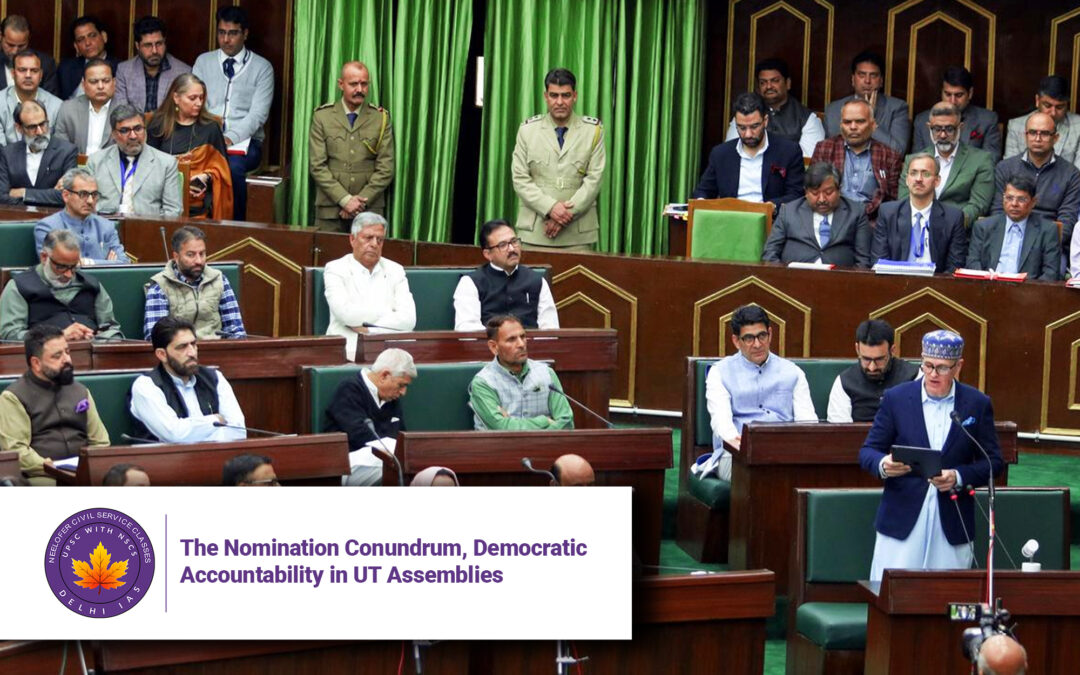The Nomination Conundrum, Democratic Accountability in UT Assemblies
Introduction
The recent affidavit filed by the Union Home Ministry before the Jammu & Kashmir and Ladakh High Court, asserting that the Lieutenant Governor (LG) of J&K can nominate members to the Legislative Assembly without the aid and advice of the Council of Ministers, has reignited a critical debate. This issue touches upon:
-
Federalism vs. Central Control in Union Territories (UTs)
-
The Legitimacy of Nominated MLAs in democratic setups
-
Judicial Precedents on UT governance
-
Potential Manipulation of Assembly Dynamics
This article examines:
-
Constitutional and Legal Provisions for nominations
-
Comparative Analysis of J&K, Puducherry, and Delhi
-
Judicial Interpretations (including the 2023 “Triple Chain of Command” doctrine)
-
5 Key Reforms Needed
-
5 Q&A on UT Nominations
By the end, we’ll assess whether nominated members strengthen representation or undermine democracy.
Legal Framework: Who Controls Nominations?
1. Constitutional Provisions
-
Article 239A (Puducherry) & J&K Reorganisation Act, 2019: Allow Parliament to create legislatures for UTs.
-
Nominated Members:
-
Puducherry: Up to 3 members (Centre’s discretion).
-
J&K: Up to 5 members (2 women, 2 Kashmiri migrants, 1 PoK displaced person).
-
Delhi: No nominations (70 elected seats only).
-
2. Key Differences
| UT | Total Seats | Nominated Seats | Nominating Authority |
|---|---|---|---|
| J&K | 90 | 5 | LG (Centre’s affidavit claims unilateral power) |
| Puducherry | 30 | 3 | Centre (Lakshminarayanan Case, 2008) |
| Delhi | 70 | 0 | Not applicable |
Judicial Precedents: Democracy vs. Central Overreach
1. Lakshminarayanan v. Union of India (2008)
-
Madras HC Ruling: Centre can nominate Puducherry MLAs without consulting UT ministers.
-
Supreme Court: Later set aside recommendations for reform, leaving ambiguity.
2. Govt of NCT Delhi v. Union of India (2023)
-
“Triple Chain of Command” Doctrine:
-
President (for UTs)
-
LG (as Centre’s representative)
-
Elected Govt (for day-to-day administration)
-
-
Implication: Reinforces Centre’s supremacy in UT governance.
Why Nominated MLAs Are Controversial
1. Subverting Electoral Mandates
-
J&K Example: 5 nominated MLAs could tilt a hung assembly (e.g., converting a 26-seat majority into a minority).
-
Puducherry (2021): Congress govt fell after 3 BJP-backed nominees joined opposition.
2. Lack of Democratic Accountability
-
Nominated members owe allegiance to nominators (Centre/LG), not voters.
-
No recall mechanism if they act against public interest.
3. J&K’s Unique Case
-
Pre-2019: Had more autonomy than other states.
-
Post-2019: UT status + nominated members = Perceived democratic backsliding.
5 Reforms for Democratic Integrity
1. Clarify Nomination Procedures
-
Parliamentary Amendment: Define if LG/Centre must consult UT ministers.
2. Restrict Nominated Members’ Voting Rights
-
Model: Like Rajya Sabha nominees, bar them from confidence/no-confidence motions.
3. Transparency in Selection
-
Public Criteria: E.g., Kashmiri migrant nominees must prove residency.
4. Restore J&K’s Statehood
-
Eliminate Nominations: Only elected reps should legislate.
5. Judicial Review
-
Constitutional Bench: Re-examine if nominations violate basic structure doctrine.
5 Key Q&A on UT Nominations
Q1: Why does J&K have nominated MLAs but not Delhi?
A: Historical reasons. J&K’s Reorganisation Act (2019) added nominations for “underrepresented groups”, while Delhi’s Act (1991) doesn’t permit them.
Q2: Can nominated MLAs topple governments?
A: Yes. In Puducherry (2021), 3 nominees helped defeat the Congress govt.
Q3: Does the President/LG need ministers’ advice for nominations?
A: No clear law. Courts have ruled both ways (Puducherry: Centre decides; J&K: LG’s affidavit claims unilateral power).
Q4: Are Anglo-Indian nominations relevant here?
A: No. That provision (Article 331) was abolished in 2020. UT nominations are governed by separate Acts.
Q5: What’s the “triple chain of command”?
A: SC’s 2023 framework prioritizing:
-
President > 2. LG > 3. Elected Govt — reinforcing Centre’s control over UTs.
Conclusion: Nominations vs. Democracy
Nominated members—whether in J&K or Puducherry—risk becoming tools for political engineering. While they may represent marginalized groups, their undemocratic selection and voting powers undermine federalism.
The Way Forward:
Limit nominations to symbolic roles (no voting on govt formation).
Restore J&K’s statehood to end exceptionalism.
Judicial clarity on the LG’s role.
As former IAS officer Rangarajan B argues, “Political differences shouldn’t rupture popular mandates.” If India’s UTs are to be truly democratic, nominations must either be reformed or abolished.
Author
Rangarajan B
Former IAS Officer & Author of “Courseware on Polity Simplified”







